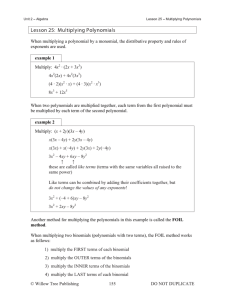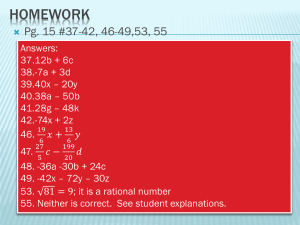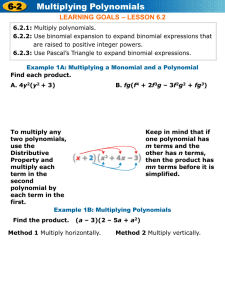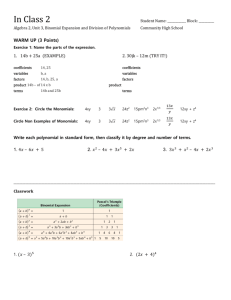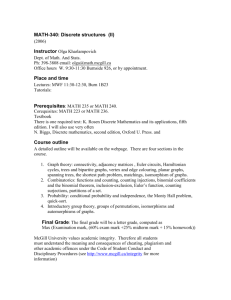Unit 4 ~ Contents
advertisement
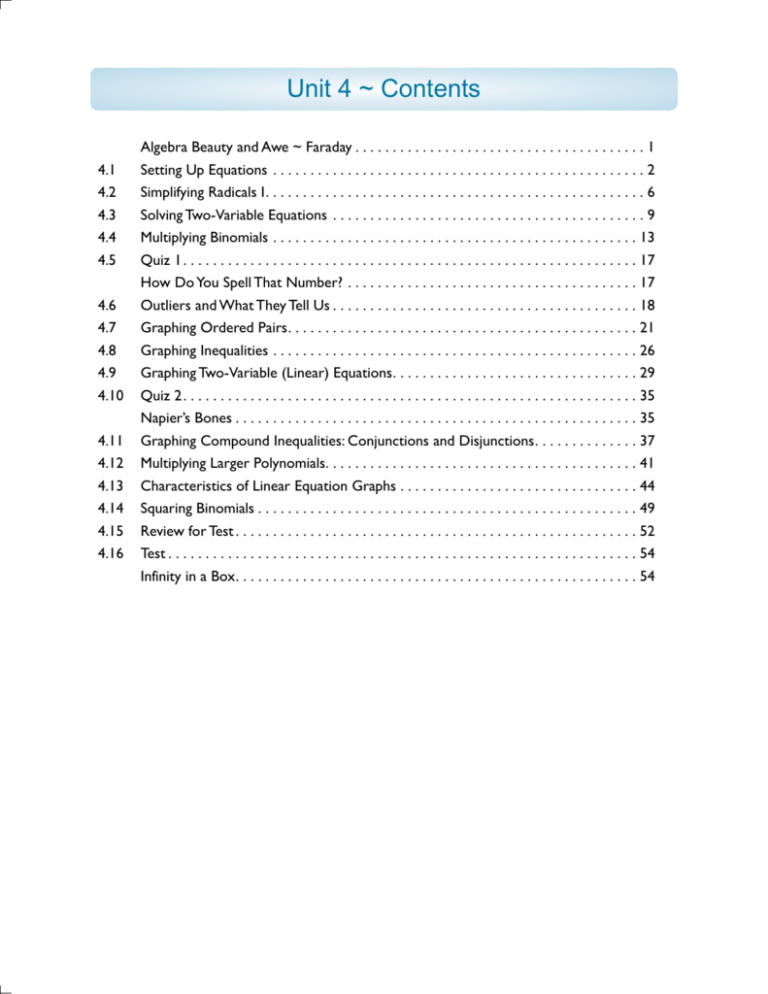
Unit 4 ~ Contents 4.1 4.2 4.3 4.4 4.5 4.6 4.7 4.8 4.9 4.10 4.11 4.12 4.13 4.14 4.15 4.16 Algebra Beauty and Awe ~ Faraday . . . . . . . . . . . . . . . . . . . . . . . . . . . . . . . . . . . . . . . 1 Setting Up Equations . . . . . . . . . . . . . . . . . . . . . . . . . . . . . . . . . . . . . . . . . . . . . . . . . . 2 Simplifying Radicals I. . . . . . . . . . . . . . . . . . . . . . . . . . . . . . . . . . . . . . . . . . . . . . . . . . . 6 Solving Two-Variable Equations . . . . . . . . . . . . . . . . . . . . . . . . . . . . . . . . . . . . . . . . . . 9 Multiplying Binomials . . . . . . . . . . . . . . . . . . . . . . . . . . . . . . . . . . . . . . . . . . . . . . . . . 13 Quiz 1 . . . . . . . . . . . . . . . . . . . . . . . . . . . . . . . . . . . . . . . . . . . . . . . . . . . . . . . . . . . . . 17 How Do You Spell That Number? . . . . . . . . . . . . . . . . . . . . . . . . . . . . . . . . . . . . . . . 17 Outliers and What They Tell Us . . . . . . . . . . . . . . . . . . . . . . . . . . . . . . . . . . . . . . . . . 18 Graphing Ordered Pairs. . . . . . . . . . . . . . . . . . . . . . . . . . . . . . . . . . . . . . . . . . . . . . . 21 Graphing Inequalities . . . . . . . . . . . . . . . . . . . . . . . . . . . . . . . . . . . . . . . . . . . . . . . . . 26 Graphing Two-Variable (Linear) Equations. . . . . . . . . . . . . . . . . . . . . . . . . . . . . . . . . 29 Quiz 2 . . . . . . . . . . . . . . . . . . . . . . . . . . . . . . . . . . . . . . . . . . . . . . . . . . . . . . . . . . . . . 35 Napier’s Bones . . . . . . . . . . . . . . . . . . . . . . . . . . . . . . . . . . . . . . . . . . . . . . . . . . . . . . 35 Graphing Compound Inequalities: Conjunctions and Disjunctions. . . . . . . . . . . . . . 37 Multiplying Larger Polynomials. . . . . . . . . . . . . . . . . . . . . . . . . . . . . . . . . . . . . . . . . . 41 Characteristics of Linear Equation Graphs . . . . . . . . . . . . . . . . . . . . . . . . . . . . . . . . 44 Squaring Binomials . . . . . . . . . . . . . . . . . . . . . . . . . . . . . . . . . . . . . . . . . . . . . . . . . . . 49 Review for Test . . . . . . . . . . . . . . . . . . . . . . . . . . . . . . . . . . . . . . . . . . . . . . . . . . . . . . 52 Test . . . . . . . . . . . . . . . . . . . . . . . . . . . . . . . . . . . . . . . . . . . . . . . . . . . . . . . . . . . . . . . 54 Infinity in a Box. . . . . . . . . . . . . . . . . . . . . . . . . . . . . . . . . . . . . . . . . . . . . . . . . . . . . . 54 4.12 Multiplying Larger Polynomials The same process used to multiply binomials works for multiplying all polynomials. Multiply every term in the first polynomial by every term in the second. Example 1 - Horizontal Method. ( 7a – 3 )( a2 – 4a + 1 ) ( 7a – 3 )( a2 – 4a + 1 ) Original problem. ( 7a3 – 28a2 + 7a ) + ( –3a2 + 12a – 3 ) Complete the multiplication. 7a3 – 31a2 + 19a – 3 Combine any like terms. 7a ( a2 – 4a + 1 ) – 3 ( a2 – 4a + 1 ) Distribute the multiplication. 7a3 – 28a2 + 7a – 3a2 + 12a – 3 Remove parentheses, identify like terms. Example 2a - Horizontal Method. ( 2x + 3y – 7 )( x – 2y + 3 ) ( 2x + 3y – 7 )( x – 2y + 3 ) Original problem. ( 2x 2 – 4xy + 6x ) + ( 3xy – 6y 2 + 9y ) + ( –7x + 14y – 21) Complete the multiplication. 2x ( x – 2y + 3) + 3y ( x – 2y + 3 ) – 7 ( x – 2y + 3 ) 2x 2 – 4xy + 6x + 3xy – 6y 2 + 9y – 7x + 14y – 21 2x 2 – x – xy + 23y – 6y 2 – 21 Distribute the multiplication. Remove parentheses. Combine any like terms. Method 2b - Vertical. Write the first binomial over the second and multiply in the same order as you multiply three three-digit numbers, beginning with the lower right hand term. 2x + 3y – 7 x – 2y + 3 – 4xy – 6y 2x 2 + 3xy 2x 2 2 – x y – 6y 2 6x + 9y – 21 –7x –x The first binomial written. The second binomial written underneath the first. Terms of the first binomial multiplied by 3. + 14y Terms of the first binomial multiplied by – 2y. + 23y – 21 Terms combined. Terms of the first binomial multiplied by x. 4.12 Multiplying Larger Polynomials ~ 41 Multiply the polynomials. 4.12 1. (4x + 3)(x2 – x + 8) 2. (x + 1)(x 2 – x + 1) 5. (x + 1)(x 2 – 2x + 5) 6. (x – y)(2x + 3y + 4) 3. (2y + 3)(y 2 – 6y + 4) 4. (3x – 1)(4x 2 + 2x – 5) 7. (x – y)(2x + 4y – 3) 8. (4z – 4)(5y + 2z + 2) Review Draw solution graphs for these compound inequalities. 4.11 9. x < 0 or x > 9 10. x ≥ 20 and x ≤ 37 Write compound inequalities for these graphs. 4.11 11. –1 5 12. 5 20 Write the answers. 13. Find the volume of a box whose dimensions are (x + 2), (2x + 1) and 5x. (3.4) 14. The width of another box is x inches. The length is 2 inches longer than the width and the height is three times the width. What are the dimensions of the box? 15. What is the volume of this box? Label and algebraically represent the values. 3.8 16. The length of the Rio Grande River is half the length of the Mississippi River, while the Mekong River is two-thirds the length of the Mississippi River. 17. There are five more people traveling to the misson in Belize than to El Salvador, but there are twice as many going to Kenya as El Salvador. Find ordered-pair solutions using the given values for x. 4.3 18. y = 4x – 1 for – 2, 0, 1 19. 5x + 2y = 1 for –1, 0, 1 Solve the equations by eliminating the fractions or moving the decimals. 3.9 3x 5x 2x x 1 3x 20. – = –6 21. – + = –4 22. 1.8x = – 3.2x + 15 5 10 2 3 6 2 42 ~ Algebra I Unit 4 Solve the equations for the specified variable. 3.14 23. 6x + 5y = –30 for y 24. a2 + b 2 = c 2 for c 25. d = rt for t On graph paper, graph each equation using the given values for x. 4.9 26. 2x – 3y = – 4 27. x + 5y = 8 x = –5, 1, and 4 x = –7, –2, 8 Factor the GCF (if any) out of the polynomials. 3.12 28. 18x 3 + 6x 2 + 3xy 29. 18x 3y + 27xy 2 30. 3yz + 7xy – 6xz 31. 24xy 2 – 6x 2y + 2xy Write the answers. 4.6 $ 32. $ 33. Roy and Ida had five children from 1906 to 1919. The life spans (in years) of their children: 102, 98, 95, 90, 77. How far apart are the median and mean life spans? If the outlier is ignored, how far apart are the median and mean life spans? Simplify. Show the factoring of the radicals in your answer. 4.2 3 34. √128 35. √162 36. √150 Multiply by the method of your choice. 4.4 38. (2x – 4)(2x + 3) 39. (5x – 3)(2x + 4) 3 37. √32 40. (x 2 – 7)(x 2 + 7) Use the six steps to set up and solve the equations. 4.1 41. Bill milks 11 less than twice as many cows as Erwin. Together they milk 109. How many cows does each man milk? a) Erwin’s cows = (x), Bill’s cows = (2x – 11) 42. Mary gathered 7 fewer eggs than Cindy, who gathered 4 more than Esther. The girls gathered 52 eggs total. How many did each gather? Multiply the polynomials. 4.12 43. (x + 2)(x 2 – x + 1) 45. (x 2 + x + 3)(x – 3) 44. (– 3m + 7)(2m + 2n – 9) 46. (m + n + p)(– n + p) 4.12 Multiplying Larger Polynomials ~ 43 4.13 Characteristics of Linear Equation Graphs y Figure 1 8 = x 4 y Figure 1 shows the graph of the simple two-variable equation: y = x. For every solution to this equation, the y-value is exactly the same as the x-value. When x is 3, y is 3. When x is – 2, y is – 2. When x is 234, y is 234, etc. -8 4 -4 8 x -4 -8 Figure 2 y x = y y = x 4 4 8 x – 5 -4 -4 = -8 y If the equation is changed by adding 3 to the x side of the equation (y = x + 3), every y value will be 3 more than the x-value. A few examples of solutions are (0, 3), (1, 4), (– 4, –1), and (100, 103). Adding 3 to x will change the graph, moving the line up 3 units on the y-axis. This can be seen in Figure 2. Similarly, if 5 is subtracted from x, the graph of the equation moves down the y-axis 5 units. + 3 8 -8 Multiplying the x value of a linear equation will also change its graph. In the equation y = 2x, every y-value will be twice the x-value. Several solutions are the ordered pairs (1, 2), (3, 6), (150, 300), and (– 4, – 8). Compare the following graphed lines to their equations to see how multiplying x by different values affects the graph. 44 ~ Algebra I Unit 4 x a y y b y c x x y = 1x y d x y = 2x x y = 4x y = 8x As x is multiplied by numbers greater than 1, the angle of the line, called the slope, increases, or gets steeper. The greater the coefficient of the x, the closer the graph comes to a vertical line. If x is multiplied by numbers less than 1, the slope decreases, approaching a horizontal line with a slope of zero (0), as the following graphs show. e y y f g x y h x y = 1x y= 1 2 y x y= x 1 4 x y = 0x x Finally, if the coefficient is decreased further (into negative values), the slope of the lines also continues to decrease until the graph again approaches being a vertical line. i y j y 1 2 y x x y=– x k y = –1x l y x y = – 2x x y = – 8x The graphs on these pages illustrate how transforming the simple linear equation (y = x) by adding a constant or multiplying the x-value changes the graph of the equation. The graph of the equation reveals what constant was added by where the line crosses the y-axis. If it crosses the axis at 0, no constant was added. If it crosses at –7, it is clear that a (–7) was added. And so on. 4.13 Characteristics of Linear Equation Graphs ~ 45 The slope of a graphed line reveals what coefficient the x variable had in the equation. The amount of slope is measured by the number by which x is multiplied, so if an equation is y = 8x, the slope is said to be 8. Using these two characteristics, the equation of a line can be determined from its graph. Example 1. Using the graphs on page 45 for comparison of the slopes, determine the equations for the following graphs. y This graph has the same slope as graph b on page 45, whose equation is y = 2x (a slope of 2). The graph also crosses the y-axis at –1, so it must be that –1 was added to the basic equation. Therefore, the equation for this line is y = 2x – 1. x This graph has the same slope as graph i on page 45, 1 1 whose equation is y = – x (a slope of – ). 2 2 The graph also crosses the y-axis at 3, so it must be that 3 y was added to the basic equation. 1 Therefore, the equation for this line is y = – x + 3. 2 x Write an equation for each graph, using the graphs on page 45 to find the slope values. 4.13 y 1. y 2. x 5. y 46 ~ Algebra I Unit 4 4. x 6. x y 3. y x x 7. x y y 8. x y x Review Multiply the polynomials. 4.12 9. (3x – 2)(2x 2 + x – 4) Calculate. 1.2 11. | 23 | • 8 + | – 6 | 10. (2x + 1)(3x – 2y – 2) 12. 63 ÷ | 15 – 6 | – 11 13. | – 5 | + | 44 | ÷ 11 Label and algebraically represent the values. 2.14 14. twice as many quarters as nickels in the cash drawer 15. The Kelvin scale is 273 more than the Celsius scale. Show both in terms of x. 16. Joseph gave 10% of his earnings to the mission fund. Write the answers. 4.6 $ 17. The names and ages of persons in a small school in West Virginia were Bradley - 10, Janet - 47, Jeanie - 8, Marvin - 14, Matthew - 13, Michael - 15, Susanna - 11, Travis - 10 and Trevon - 11. a. Who was the teacher? b. What was the average age of the students? c. What was the median age of all the individuals in the school? $ d. When school let out in the spring, the mean of the students’ ages was not 1.0 more than the mean $ 18. age when school started. Why? Wyatt read the five chapters of Lamentations. He noticed the number of verses in each chapter: 22, 22, 66, 22, 22. Find the mean and the median number of verses per chapter. Round to the nearest tenth. Combine like terms in the expressions. 2.3 19. rs + 4rs – 6s – s 2 + 5s 2 20. 2r + 12r + 11rs3 – 6 – 7rs 3 – 3r Distribute the division and simplify. 2.13 21. (21x 2 + 14x – 7) ÷ 7x 22. (4n 2 – 2n) ÷ 8n 23. (25x 3 – 10x 2 + 30x) ÷ 5x Write monomial, binomial, trinomial, or polynomial. Complete the description by writing the number of variables and degree. 3.2 24. 5jk 2l 25. 2k – 5k 2 4.13 Characteristics of Linear Equation Graphs ~ 47 Simplify. 1.14 26. √ 36 64 27. √– 64 28. √49 3 Multiply the terms. 2.4 30. 3mn • 3m 3np • 9m 2n2p3 Solve. 2.12 33. 7 + 4y = 31 29. √– 6 31. m2n3 • 5mnp • 8m3 32. 4m • mn • 6m2n3 34. 2x + 7 = 4x – 9 35. 3k + 6 – 5k = 7k – 21 Subtract the polynomials. 3.11 36. (4x 2 – 2x + 3) – (2x 2 + 2x – 9) 37. (3m 2 – 2m – 2) – (– 3m + 2) Draw the solutions graphs. 38. The compound inequality –39°C ≤ x ≤ 357°C describes the approximate temperatures at which mercury, also known as quicksilver, is a liquid. Draw the solution graph. (4.11) 39. As is implied by the previous problem, mercury in a thermometer will freeze whenever x ≤ –39°C (approximately). Draw the solution graph. (4.8) Write compound inequalities for these graphs. 4.11 40. 41. π 0 –7 7 Draw solution graphs for these compound inequalities. 4.11 42. x ≤ 4 or x > 11 43. 100 ≤ x < 101 Write an equation for each graph, using the graphs on page 45 to find the slope values. 4.13 44. y 45. x 48 ~ Algebra I Unit 4 y 46. x y 47. x y x 4.14 Squaring Binomials Recognizing the pattern that occurs when squaring a binomial using the FOIL method simplifies the process. Squaring a binomial: (x + 3)2. (x + 3)(x + 3) x • x = x2 (x + 3)2 = (x + 3)(x + 3) F = First terms multiplied. (x + 3)(x + 3) O = Outer terms multiplied. 3x + 3x = 6x Products of outer and inner terms combined. x 2 + 6x + 9 binomial squared. (x + 3)(x + 3) 3•3=9 I = Inner terms multiplied. L = Last terms multiplied. To simplify a binomial such as (x + 3)2 , follow this pattern: square the first term of the binomial (x • x = x 2), double the product of both terms (2 • 3x = 6x), and square the second term (3 • 3 = 9). The result is x 2 + 6x + 9; the same answer as using the FOIL method. This pattern holds true for squaring any binomial. The process can be thought of as the “square, double, square” rule. (a + b)2 = a2 + 2ab + b2 Squaring a Binomial: 1. Square the first term. 2. Double the product of both terms. 3. Square the second term. Example 1. Simplify the binomial (2a + 7)2. (2a + 7)2 Original problem. 4a2 + 28a Product of first and second terms doubled. 4a2 4a2 + 28a + 49 First term squared. Second term squared. 4.14 Squaring Binomials ~ 49 Example 2. Simplify the binomial (2x 2 + 3y 2)2. (2x 2 + 3y 2)2 Original problem. 4x 4 + 12x 2y 2 Product of first and second terms doubled. 4x 4 First term squared. 4x 4 + 12x 2y 2 + 9y 4 Second term squared. Simplify the binomials mentally (square-double-square). 4.14 1. (x + 2)2 2. (x – 4)2 4. (y + 10)2 5. (x – 10)2 Review 3. (a + 7)2 6. (3a – 2)2 Write an equation for each graph, using the graphs on page 45 to find the slope values. 4.13 y 7. 8. x y y 9. x 10. y x Find ordered-pair solutions using the given values for x. 4.3 11. y = x – 2 for x = – 1, 0, 2 3 3 12. y = 4 x + 5 for x = 0, 4, 8 Use the six steps to set up and solve the equations. 4.1 13. Richard’s earnings for the first week of December were $45 less than the second week and $21 more than the third week. The total earnings for the three weeks were $1,440. What were the earnings for each week? a) first week = (x) 14. Maynard’s electric kilowatt usage in June was 65 kilowatts more than one-fourth his usage in January. If the total kilowatts used for the two months was 3,440, how much was used in each of the two months? a) January usage = (x) 50 ~ Algebra I Unit 4 x Solve the equations for the specified variable. 3.14 15. Ax + By = C for y 16. q = mcT for m 17. 5x – 4y = 20 for y Simplify. Show the factoring of the radicals in your answer. 4.2 3 18. √40 19. √81 20. √50 3 $ 21. √363 Multiply by the method of your choice. 4.12 22. (x – 1)(6x + 3) 23. (2x + 3)(x 2 + 3x + 5) 24. (5x 2 – 1)(x 2 – 3x + 2) Draw solution graphs for these inequalities. 4.8 25. x < 28 26. x > – 4.2 27. x ≥ 16 Factor the GCF (if any) out of the polynomials. 3.12 28. 14p4q + 28pq 2 29. 9x 2 – 4xy + 12y 30. 15x 2y 3z – 10xyz 3 31. 21m4n2 + 14m2n + 28m2 Draw the solution graph for each equation using the given values for x. 4.9 32. x – 3y = – 9 33. x = – 3, 3, and 6 x – 3y = 2 x = – 4, –1, and 5 Follow the directions. 9 x + 32 connects the Celsius (x) and Fahrenheit (y) temperature scales. On graph 5 paper, set up the y-axis (Fahrenheit temperature) so that it goes from – 40 to 50. Set up the x-axis 34. The equation y = (Celsius temperature) so that it goes from – 40 to 10. For each axis, let a block represent 5 units. Draw the solution graph for the equation using x = – 40, –15, and 10. (4.9) 35. From the graph drawn in problem number 34, what appears to be the Celsius temperature equivelent to 23°F.? 9 36. Solve the equation 23 = x + 32 for x. This will give the exact temperature for 23°F. 5 Simplify the binomials mentally (square-double-square). 4.14 37. (a + b)2 38. (2x + 1)2 39. (x 2 – 8)2 4.14 Squaring Binomials ~ 51
